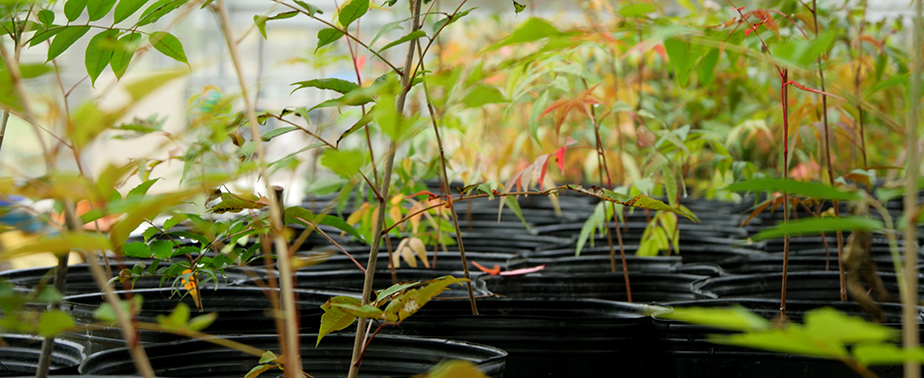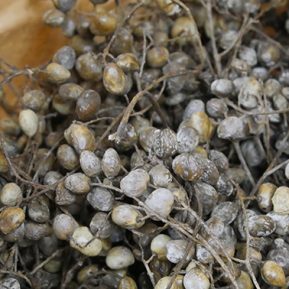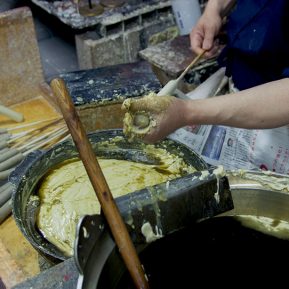
There were many concerns involved in the transplanting of Haze trees grown in warm locations like Kyushu, Shikoku, and Wakayama to Keihoku. There is a broad range of temperatures throughout the day in Keihoku, and snow accumulates on the ground in the winter. Although there are many forestry professionals in Keihoku, they knew nothing about the Haze tree. However, the Yama Haze variety—which has grown in the forests of Keihoku since ancient times—inspired a sliver of hope among the participants.
Yoji Mishima, director of Kyoto City’s Keihoku Agriculture and Forestry Promotion Center, said, “The Yama Haze is technically a different variety than the trees from which Haze Wax is harvested, but we were encouraged by the presence of this tree that is a member of the same family. Having experienced all four seasons after the launch of this project, we finally felt stirrings of confidence that we could successfully grow Haze in this climate. However, the grafting technique was quite difficult. Selective Haze breeding via grafting has taken place since the Edo Period, and production of this tree was increased by making more clones. We had to continue cultivation with grafting to protect the variety, but the ratio of grafts that take is very small.”
Repeated selective breeding is performed to harvest larger amounts of higher-quality wax, so Haze grown from seeds are of a variety that is closer to the original one. The only way to maintain wax quality is by grafting a scion (bud or branch) onto a rootstock (root of the same variety). Of the 200 trees grafted in 2016, only two have survived—a success rate of just 1%. Even the grafting specialists in Kyushu and Shikoku who have been in charge of past Haze Wax production have a success rate of around 20%. There is only one opportunity to perform grafting each year: early spring, before the tree produces shoots. In the future, the project members will continue growing Haze trees, mainly adult trees transplanted from other production areas and grafted seedlings, while attempting to boost the grafting success rate.
There are currently 184 Haze trees growing in the Keihoku region: three adult trees, 12 grafted seedlings (three years), two grafted seedlings (one year), and seedlings (one year). They are cultivated at four sites in this region, both in the mountains and other outdoor locations, to mitigate the dangers posed by wild animals and weather.
The real circumstances in this sparsely populated region
Kazutoyo Kajitani (Kyoto Farm LC), who works in the local agriculture industry, takes part in experimental Haze cultivation for the Kyoto Eternal Light Project. He provides some of his farmland and watches over the 50 Haze trees there, and is also involved in the operation of the project as one local volunteer. He said, “The time came when we had to think about new industrial promotion using the forest and fallow fields in the area. I hope that Haze Wax becomes a main industry after forestry and agriculture, and I also want to revitalize the region with new businesses. After all, this is a sparsely populated area even though it is just one hour by car from Kyoto City.”
This year, only four children entered first grade at an elementary school in the Keihoku region. There are also few young people around their 40s, like Kajitani, who should be playing central roles in the region. “Before thinking about industrial promotion or regional vitalization, I felt a strong sense of fear that our regional community might fall apart,” said Kajitani. “There is no future in Keihoku unless we young people join hands and work toward a common goal. Wa Rosoku are important, as is industrial promotion. However, to me the most important thing was somehow working together and making great efforts with my comrades in the region. Honestly, any goal might have sufficed in that case.”

Another local project member is Takashi Kajitani of Kikobo Kaji. He said, “This project has to be enjoyable, since for the immediate future people will be volunteering in between their regular work. It will also make children interested in the region if they see adults working while having fun.” Haze leaves turn colors in the autumn, so this cultivation and growing will transform the scenery of Keihoku. The members intend to plant trees along main roads with the hope of creating future tourist attractions. People throughout the region are frankly discussing how to grow these trees and also transporting the saplings together. These experiences strengthen feelings of unity between the participants and help show children the energy in their home region. The locals, who are receiving no compensation for their participation until the project gets on track, all have their own reasons for taking part.
Haze’s role in education
Keihoku’s Kitakuwada High School is the only school in Kyoto Prefecture with a specialized forestry department, called the “Forestry Research School.” There, specialists are developed with great knowledge in afforestation, lumbering, and other elements of mountain forest management, as well as carpentry, architecture, and forestry issues including the environment. The school’s nursery house is utilized for this project as a place where students work to grow Haze trees as part of their practical training.

Vice Principal Takeshi Fukuyama said, “We plan for students to learn about the entire process from Haze growing to Wa Rosoku production using the wax. Our students also study woodworking techniques, so they try making candlesticks and other items. I want to inspire students to think not only about building materials, but also about forestry by focusing on the products that are made from trees.”

Forestry Research School teacher Ikuto Ichino in the school’s nursery house
Roughly 80% of Kitakuwada High School’s Forestry Research School students proceed to higher education outside of the Keihoku region. In the past most of the graduates entered the forestry industry, but today many of them pursue further education or find jobs at regular corporations. “That is exactly why I want these three years spent learning about forestry in this location to be a valuable experience,” stated Ikuto Ichino, a teacher in the Forestry Research School. He said, “Our forests have no future if young people aren’t aware of their decline and think about how to cope with this. There are still unexplored fields for trees, as shown by how Haze Wax is utilized in various fields. Many of our past classes taught about the utilization of adult cedar and cypress trees, but I am hoping to provide opportunities for students to learn various applications through the process of growing Haze trees from seeds.” Kitakuwada High School also plans to plant Haze trees on its campus.

If the seeds planted by the students this spring grow successfully, they can be used as grafting rootstocks in around two years. Kitakuwada High School will hand over the Haze growing tasks to younger students.
(To be continued)
SPECIAL
TEXT BY YUJI YONEHARA
PHOTOGRAPHS BY SHINGO YAMASAKI
16.11.23 WED 15:28




